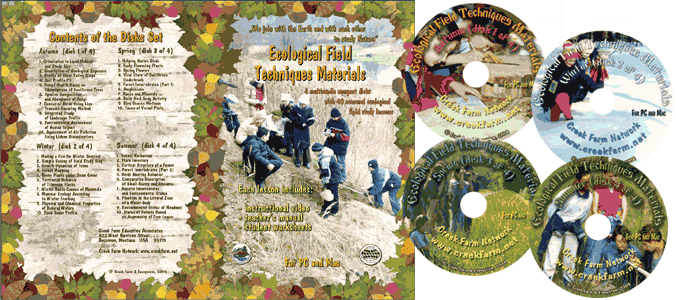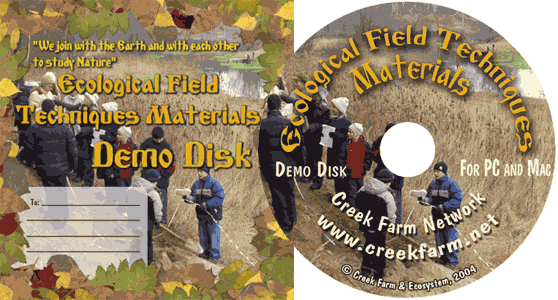|
| Our Field Ecology Center published more than
180 methodical materials for nature studies. Some of them are in English: |
|
|
|
Assessment of Ecological Features of Meadows on the Base of
Vegetation Cover
© Alexsander S. Bogolyubov,
Russia, 2002
© Michael J. Brody, USA,
2003
 This manual contains a
procedure for bioindication of ecological conditions in meadow plant associations
according to the species composition and abundance of plants. Without any geographical,
physical, chemical or historical studies, it is also possible to determine important
characteristics of habitat physical conditions. This manual contains a
procedure for bioindication of ecological conditions in meadow plant associations
according to the species composition and abundance of plants. Without any geographical,
physical, chemical or historical studies, it is also possible to determine important
characteristics of habitat physical conditions.
This field study has instructional video
featuring real students conducting the ecological field techniques in nature. Each video
illustrates the primary instructional outcomes and the major steps in accomplishing the
task including reporting the results.
Introduction
This research is one of the most difficult and laborious studies within the given
series, as it requires knowledge of herbaceous plant species, skills to make
geobotanical descriptions of meadow plant associations, as well as the ability to
process quantitatively obtained data.
The present lesson is based on one of the most interesting bioindication methods. Bioindication
is the determination of different environmental characteristics according to living
objects. In the given case, objects of bioindication are meadow plant associations. This
procedure allows us to determine the main geographical and physical characteristics
of these plant associations on the basis of only the description of the species
composition of plants growing in the meadow, without conducting any geographical
(geomorphological, geological and soil), physical, chemical or historical studies.
Long-term work of the Russian soil agronomist and botanist L.G. Ramensky, who carried
out large-scale studies in 1940-50s, is used as the basis of the procedure. Ramensky
analyzed vast materials collected in different regions of the country where he studied the
species composition of meadows and their physical properties at the same time. Comparing
species composition and abundance of plants in meadows located in areas with different
physical properties, he determined colonization patterns of different meadow types by
different plant species. Due to his works, the УComparative ecological tables of
plantsФ were developed, which are described in this manual. Using the tables, a
researcher can describe values of certain physical properties of the area under study on
the basis of plants found in the meadow.
L.G. Ramensky studied five ecological characteristics (УscalesФ) of meadow
plant associations: 1) scale of УmoistureФ (denoted by a letter УMФ in the
tables); 2) scale of moisture variability (MV); 3) scale of Уactive soil richness and
salinityФ (RS); 4) scale of alluvialness (A) and 5) scale of Уpasture digressionФ
(PD). What the scales are, what they characterize and how researcher can evaluate the
position of a given meadow plant association on the basis of each of the scales Ц all
these issues will be discussed below in the section called УCharacteristics of
scales-gradations of ecological conditions.Ф
Students are required to have the following equipment for conducting the studies: forms
for geobotanical descriptions (or field diaries or notebooks), complete (scientific) field
guides of herbaceous plants and comparative ecological tables, given in the present
manual.
General organizational plan of studies
It is recommended to organize the students conducting these studies with the example of
3-5 meadow plant associations that are known to differ in physical properties of their
environments. For instance, it is possible to include and describe meadows found at
different distances and at different heights according to the riverbed. This will provide
an opportunity to compare meadows with different types of moisture, moisture variability,
soil richness and alluvialness.
The total amount of work, i.e. the number of different types of meadows studied in the
course of research depends as usual on the availability and qualification of Уlabor
resourcesФ and time. Two or three students can carry out a standard geobotanical
description of a meadow. Each team of students conducts the description of two or three
types of meadows found in the vicinity of the field studies center. When planning the
studies, it is necessary to take into account the fact that fieldwork takes relatively
little time (not more than an hour for description of one meadow); most of your time will
be spent processing the field material (determination of unknown species and work with
tables).
Requirements for the fieldwork in the course of given studies include studentsТ
knowledge of all the species of herbaceous plants or the availability of
complete (scientific) field guides as well as the skills to conduct description of
herbaceous vegetation.
Technique for geobotanical descriptions of meadow vegetation
Description of meadow vegetation is carried out according to a standard scheme.
A site for description of 1m x 1m in size is laid down in an average, middle
part of the meadow. The corners of the site are marked with pegs for convenience and
visibility, and the borders of the site are marked with strings (or one meter long ...
This was only the first page from the manual and its full version you can see in the
Ecological Field Studies Techniques Video 4CD Set:
It is possible to purchase the complete set of 40 seasonal Ecological Field
Studies Techniques Video (in mpg format) in an attractive 4 compact disk set.
These compact disks are compatible with Mac and PC computers.
The videos are suitable for individual student or whole class instruction. To purchase the complete 4CD set
write to ecosystema1994@yandex.ru in a free form.

Ecological Field Studies Demo Disk:
We also have a free and interesting demonstration disk that explains our ecological field studies approach.
The demo disk has short excerpts from all the seasonal field study videos as well as sample text from all the teacher manuals.
The disk has an entertaining automatic walk through which describes the field study approach and explains how field studies meet education standards.
You can also download the Demo Disc from ecosystema.ru/eng/eftm/CD_Demo.iso.
This is a virtual hybrid (for PC and Mac computers) CD-ROM image (one 563 Mb file "CD_Demo.iso").
You can write this image to the CD and use it in your computer in ordinary way.
You also can use emulator software of virtual CD-ROM drive to play the disk directly from your hard disk.

|







